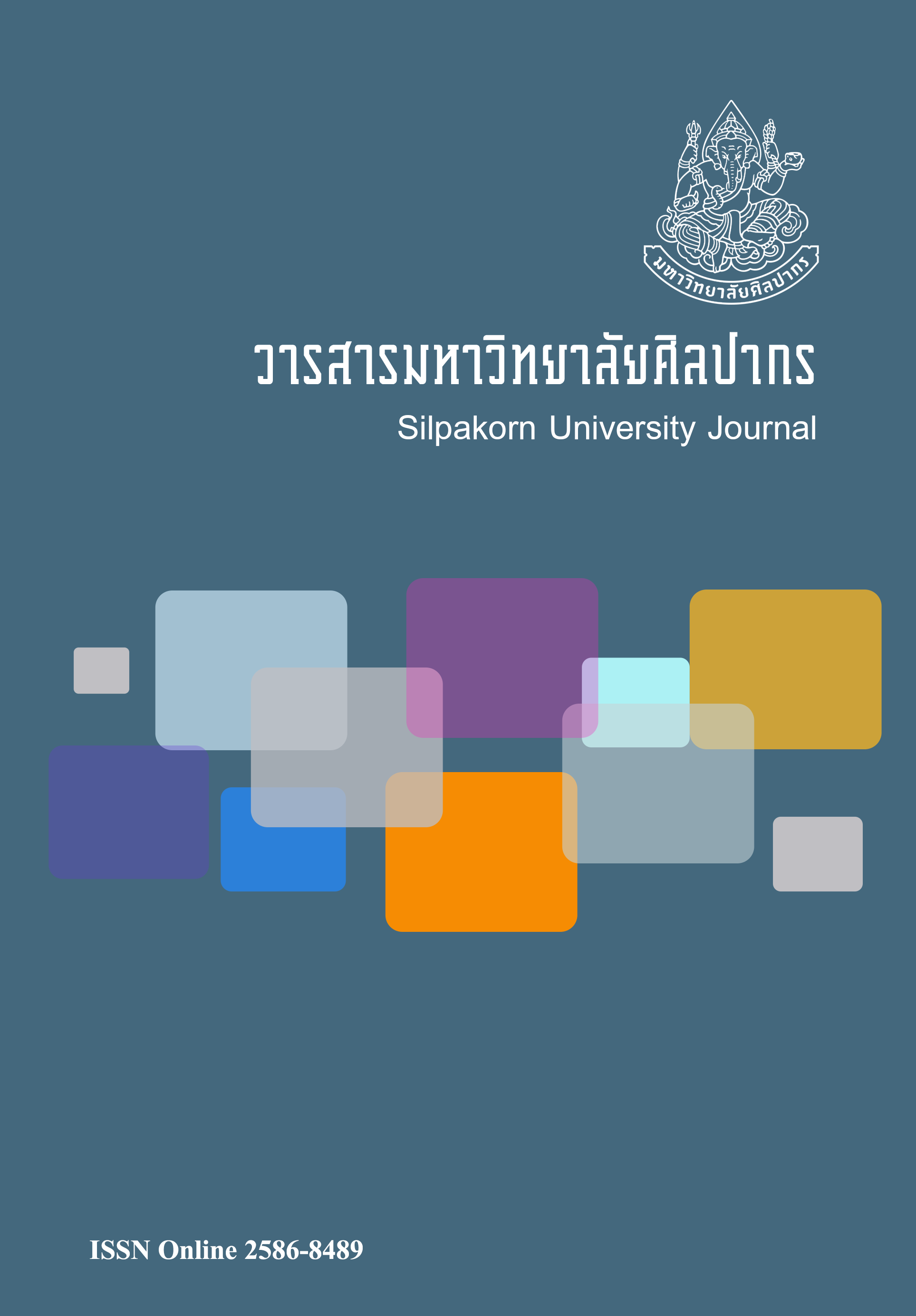ปัจจัยที่ส่งผลต่อการบริหารความเสี่ยงทางการเงินส่วนบุคคลของนิสิตมหาวิทยาลัยระดับปริญญาตรีในจังหวัดชลบุรี (Factors affecting risk management in relation to personal financial planning of undergraduated in Chonburi province)
Main Article Content
Abstract
การวิจัยนี้มีวัตถุประสงค์ 1)เพื่อศึกษาระดับความรู้ความเข้าใจ ทัศนคติ และพฤติกรรมการบริหารความเสี่ยงทางการเงินส่วนบุคคลของนิสิต 2)เพื่อเปรียบเทียบระดับความรู้ความเข้าใจ ทัศนคติ และพฤติกรรมของนิสิตที่มีต่อการบริหารความเสี่ยงทางการเงินส่วนบุคคลแต่ละชั้นปี 3)เพื่อหาความสัมพันธ์ระหว่างความรู้ความเข้าใจและทัศนคติของนิสิตที่มีต่อการบริหารความเสี่ยงทางการเงินส่วนบุคคล กลุ่มตัวอย่างที่ใช้ในการวิจัยคือ นิสิตระดับปริญญาตรี ในมหาวิทยาลัยมหาวิทยาลัยของรัฐ สังกัดคณะกรรมการการอุดมศึกษา ซึ่งมีที่ตั้งหรือวิทยาเขตอยู่ในจังหวัดชลบุรีจำนวน 415 คน โดยใช้การสุ่มตัวอย่างแบบหลายขั้นตอนเก็บรวบรวมข้อมูลด้วยแบบสอบถามที่ผู้วิจัยสร้างขึ้น วิเคราะห์ข้อมูล ด้วยโปรแกรมสถิติสำเร็จรูป สถิติที่ใช้ในการ วิเคราะห์ข้อมูล คือจำนวนหรือความถี่ ค่าร้อยละ ส่วนเบี่ยงเบนมาตรฐาน การวิเคราะห์ความแปรปรวน วิเคราะห์สหสัมพันธ์ และการวิเคราะห์ความถดถอยเชิงพหุ ผลการวิจัยพบว่านิสิตทุกชั้นปีมีความรู้ความเข้าใจ ทัศนคติ และพฤติกรรมการบริหารความเสี่ยงทางการเงินส่วนบุคคลไม่แตกต่างกันอย่างมีนัยสำคัญทางสถิติ ยกเว้นระหว่างชั้นปีที่1 (=14.98) และชั้นปีที่3 (
=13.55) นิสิตทุกชั้นปีมีความรู้ความเข้าใจการบริหารความเสี่ยงทางการเงินส่วนบุคคลอยู่ในระดับปานกลาง (
=14.41) และมีทัศนคติเห็นด้วยเชิงบวกต่อการบริหารความเสี่ยงทางการเงินส่วนบุคคล ในด้านการสำรอง การออมเงิน (
=3.78) การวางแผนการลงทุน การบริหารรายจ่าย (
=3.67) ด้านการทำประกันและการบริหารความน่าเชื่อถือทางการเงิน (
=3.61) ไม่แตกต่างกันอย่างมีนัยสำคัญทางสถิติ นิสิตทุกชั้นปีมีพฤติกรรมในการบริหารความเสี่ยงทางการเงินส่วนบุคคลในระดับน้อย (
=2.48) ไม่แตกต่างกันอย่างมีนัยสำคัญทางสถิติ ในการวิเคราะห์การถดถอยพหุคูณ พบว่า ตัวแปรทัศนคติการบริหารความเสี่ยงทางการเงินส่วนบุคคล มีความสัมพันธ์กับตัวแปรพฤติกรรมการบริหารความเสี่ยงทางการเงินส่วนบุคคลเชิงลบอย่างมีนัยสำคัญทางสถิติที่ 0.05
The objectives of this research were to: 1) investigate undergraduate students’ of knowledge and understanding of, attitude toward, and behavior related to personal financial risk management; 2) compare the level of knowledge and understanding of, attitude toward, and behavior related to personal financial risk management of undergraduate students in each year level; and 3) examine the correlation between students’ knowledge of and attitude toward personal financial risk management. Samples were 415 undergraduate students within universities located in Chonburi province selected using multi-stage random sampling. A questionnaire was employed to gather data. Data were analyzed, using a statistical package program. The following statistics were calculated: percentage, mean, pearson product moment correlation coefficient, standard deviation, analysis of variance and multiple regression. The findings indicated that students of different year level do not have statistically significantly different level of knowledge, understanding of, attitude towards and behavior related to personal financial risk management, except between the first year (=14.98) and third year (
=13.55) students. On average, students in all year levels have medium knowledge and understanding of risk management (
=14.41). Regarding attitude, students positively agree with personal financial risk management. There is no statistically significant difference among students of different year levels in terms of savings ( =3.78), the investment planning and expenses management (
=3.67), insurance and management of financial credits (
=3.61). Students of all year levels score low in terms of personal financial risk management behavior (=2.48) and there is no statistically significant difference when comparing students of different levels. The multiple regression analysis showed that “the attitude toward risk management variable was negatively correlated with personal financial risk management behavior at the significance level of .05.
Downloads
Article Details
References
Association of Internal Auditors of Thailand and The Stock Exchange of Thailand. (2008). Frame structure, risk management, enterprise integration: Guidelines (กรอบโครงสร้างการบริหารความเสี่ยงขององค์กรเชิงบูรณาการ : แนวทางปฎิบัติ) (1st ed.). Bangkok: Amarin Printing and Publishing Plublic Co., Ltd.
Aurora, C. & Bacovia, G. (2009). Basic principles of hedge accounting. Journal of Munich Personal RePEc Archive, 3, 1-14.
Britt, et al. (2015). Financial stress and financial counseling: helping collegestudents. Journal of Financial Counseling & Planning, 26(2),172
Fisher, et al. (2015). Gender differences in saving behaviors among low-to moderate-income households. Financial Services Review, 24(1), 1-13.
Hasmet SARIGUL. 2014). A survey of financial literacy among university students.Journal of Accounting & Finance. 64, 207-224.
Hwang, H. J. (2014). A proposal for an open-source financial risk model. Journal of Financial Regulation and Compliance, 22(3), 219–234.
Beierlein, J. J. & Neverett, M. (2013). Who takes personal Finance?. Financial Services Review, 22(2), 151-171.
Javine, V. (2013). Financial knowledge and student loan usage in college students.Financial Services Review, 22(4), 367-387.
Gold, J. l., Pryor, C., & Jagolinzer, P. (2004). Teaching Personal Finanical Planningat Business Schools. The CPA Journal, 74, 68-70.
Joehnk, et al. (2011). Planning Your Personal Finance (12th ed.). Australia: South-Western Cengage Learning.
Kasikorn Research Center. (2016). Construction Industry in the East (อุตสาหกรรมก่อสร้างในภาคตะวันออก) [Online]. Retrieved February 9, 2016 from http://www.kasikornbank.com/SME/PublishingImages/Seminar/KSME_Analysis_01042556.pdf
Katalin Huzdik, Daniel Beres and Erzsebet Nemeth. (2014) An empirical study of financial literacy versus risk tolerance among higher education students.Public Finance arterly, 59(4), 444-456.
Khowleung, P.(2005). Planning and money management (การวางแผนและบริหารเงินส่วนบุคคลด้วย Excel) (1st ed.). Bangkok: KTP Comp Sulting Co.
Krejcie R.V. & Morgan D. W. (1970). Determining sample size for research activies.Educational and Psychological Measurement, 30(3), 607-610.
Minimol, M. C. & Harikumar, L. (2013). Relationship between financial knowledge, financial attitude and financial literacy: a study among Investors in Kerala.International Journal of Applied Financial Management Perspectives, 2(4), 699–704.
Cupic, M. (2015). Risk management and corporate value. Economic Horizons Journal, 17(3), 215–228
Namphud, S. (2000). Personal financial management strategies (กลยุทธ์การบริหารการเงินบุคคล) (3rd ed.). Bangkok: Thammasat University.
Namphud, S. & Jeroenjittakam, A. (2008). Personal financial management strategies (กลยุทธ์การบริหารการเงินบุคคล) (5th ed.). Bangkok: Thammasat University.
Ning Tang, and Paula C. Peter. (2015). Financial knowledge acquisition among the young: The role of financial education, financial experience, and parents’ financial experience. Financial Services Review, 24(2),119-137
LaBorde, P. M., Mottner, S., & Whalley, P. (2013). Personal financial literacy: perceptions of knowledge, actual knowledge and behavior of collegestudents. Journal of Financial Education, 39(3/4), 1-30.
Petchsakunwong, S. (2011). World Economic Crisis 2008-2009: Cause & Effect (วิกฤตเศรษฐกิจโลก 2008-2009 : สาเหตุและผลกระทบ). Journal of Songkhla University, 4(1), 51-65.
Phusuwan, B., Janwit, P., & Siriprapanukul, P. (2013).15 years of the economic crisis in 1997: Thailand where (15 ปี วิกฤตเศรษฐกิจ 2540 : ประเทศไทยอยู่ตรงไหน) (1st ed.). Bangkok: Thaipublica Forum.
Phutthasri, S. & Sasiwuthiwat, S. (2014). Economic History of the World: The portable version (ประวัติศาสตร์เศรษฐกิจโลก : ความรู้ฉบับพกพา) (1st ed.). Bangkok: Open World Publishing House Co., Ltd.
Power, M. L., Hobb, J. M., & Ober, A. (2011). An empirical analysis of the effect of financial education on graduating business students’ perceptions of their retirement planning familiarity, motivation, and preparedne
Risk Management and Insurance Review, 14(1), 89-105.Probohudono, N. A., Tower, G. & Rusmin R. (2013). Risk disclosure during the
global financial Crisis. Social Responsibility Journal, 9(1), 124–137.Saardchom, N., Watcharasriroj, B., & Boonsathorn, W. (2008). CRO must guide
a new generation of enterprise risk management (CRO ต้องรู้ คู่มือการบริหารความเสี่ยงองค์กรยุคใหม่) (1st ed.). Bangkok: Thanbooks Co.Srisaard, B. (2002).Introduction to research (การวิจัยเบื้องต้น) (5th ed.). Bangkok: Suviriyasan.
The Office of Internal Audit Kasetsart University. (2009). Enterprise-wide risk management manual: ERM manual (คู่มือการบริหารความเสี่ยงทั่วทั้งองค์กร) (3rd ed.). Bangkok: Globalgraphic.
Wainan, J. (2009). Risk management & insurance (การบริหารความเสี่ยงและการประกันภัย) (1st ed.). Bangkok: Mistercopy(Thailand).


